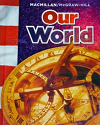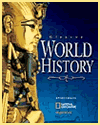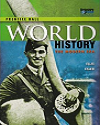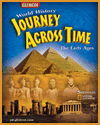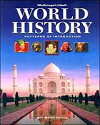| Worksheets for World History Textbooks |
| www.studenthandouts.com > Worksheets for Popular Textbooks > World History Textbooks |
| These supplemental worksheets are designed to be used alongside these popular World History-Global Studies textbooks. No copyright is implied over these books or their contents. The free printable worksheets include items like vocabulary sheets, blank outlines, and essay questions over the section readings. |
|
Utilizing textbooks in the study of World History can offer several benefits to students.
Structured Content: Textbooks for Global History classes provide a structured and organized presentation of historical information. This structure helps students grasp the chronology and key events in history.  Comprehensive Coverage: World History textbooks typically cover a wide range of topics, regions, and time periods. This comprehensive coverage ensures that students are exposed to diverse historical contexts.
Comprehensive Coverage: World History textbooks typically cover a wide range of topics, regions, and time periods. This comprehensive coverage ensures that students are exposed to diverse historical contexts. Primary and Secondary Sources: World History textbooks often include excerpts from primary sources (e.g., documents, letters) and interpretations by historians (secondary sources). This exposure allows students to engage with both original materials and expert analyses. Historical Context: These textbooks provide historical context, explaining the social, political, economic, and cultural conditions of different eras. This contextual information helps students understand the factors influencing global historical events. Maps and Visual Aids: Many Global Studies textbooks include maps, illustrations, and visual aids to help students visualize geographical locations, battle sites, and historical figures. These visuals enhance comprehension. Depth of Information: World History textbooks go into more depth than classroom lectures or brief online resources. They provide detailed explanations and analysis of historical events, which is valuable for a deeper understanding. Consistency: A Global History textbook can provide a consistent source of information and terminology throughout the course. This consistency is helpful for both students and educators. Reference Material: World History textbooks can serve as reference material, allowing students to look up information when they have questions or need clarification on historical concepts or terms. Critical Thinking: Reading textbooks encourages students to critically assess the information presented. They can evaluate different historical interpretations and perspectives, honing their critical thinking skills. Source of Homework and Study Material: World History textbooks often include study questions, review exercises, and assignments that help students reinforce what they've learned in class. Preparation for Standardized Tests: Many standardized tests and exams include questions related to World History. Studying from a textbook can prepare students for these assessments. Engagement with the Past: Textbooks can transport students to different time periods and cultures, fostering an appreciation for the experiences and challenges of people in the past. Writing and Research Skills: Using World History textbooks for research papers and projects encourages students to develop research and writing skills. They learn how to cite sources, structure arguments, and build a strong thesis based on historical evidence. Independence: Utilizing these promotes independent learning. Students can read and study on their own, allowing them to take ownership of their education and explore topics of personal interest. Classroom Discussions: These often form the basis for classroom discussions, as students and teachers reference common material to explore global historical concepts and events in greater depth. While textbooks are valuable resources in the study of World History, it is important to use them in conjunction with other learning materials, such as primary sources, documentaries, and online resources, to provide a well-rounded and engaging history curriculum. |
| www.studenthandouts.com > Worksheets for Popular Textbooks > World History Textbooks |


